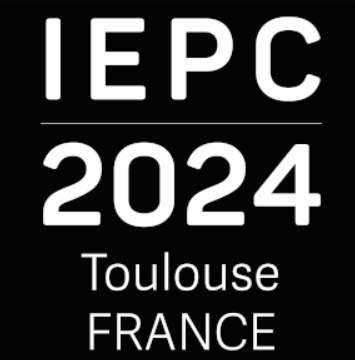News

IEPC 2024 conference report
International Electric Propulsion Conference, Toulouse, June 2024.
INTRODUCTION
This international conference is held approximately every two years. It was organized by two CNRS laboratories (ICARE in Orléans and LAPLACE in Toulouse), CNES and the Institut National Polytechnique de Toulouse.
The conference attracted over 734 participants, including 287 students and 84 visitors, who gave 600 presentations. The American delegation was the largest with 215 participants, followed by France (128), Germany (76), Japan (61), China (62), the UK (41), Spain (28) and Italy (22), not forgetting Israel.
The number of participants shows the growing interest of the space community in electric propulsion, which has become indispensable for both geostationary satellites and low-orbit constellations.
PLENARY PRESENTATIONS
After a general presentation by the organizers, the first day began with a tribute to Professor Mariano Andrenucci, who passed away in March 2024, and one of the main organizers of the IEPC conferences. This was followed by presentations from Lionel Suchet, Director of CNES, and Jean-Marie Bétermier, Vice President Space at Safran Electronics and Defense.
Mr. Vlad Hubry (BUSEK) presented the "David C. Byers memorial lecture" on the various aspects and techniques involved in electric propulsion, from SMEs to major corporations.
A plenary session was devoted to a presentation on thermonuclear space propulsion. The (very advanced) concept uses pulsed magnetoinertial confinement and is aimed at power levels well below those of TOKAMAK-type fusion devices (Setthivoine You, Helicity).
The second plenary session dealt with issues of law in space (Alain Guyomarch, ANRT). The term itself was coined in 1910, and the first book was written in Germany in 1932.
The cornerstone of space law is the UN General Assembly Resolution (1963) and the Space Treaty (1967).
A Moon Agreement was drawn up in 1979. In the case of the International Space Station, the national law of the state that built the module applies. This is particularly important for the intellectual property of experiments carried out.
The ARTEMIS agreement applies to the signatory states (USA, Canada, South America, Europe, India, Japan). But there is also an ILRS agreement linking Russia, China, Egypt and Turkey. It is expected that the bases of both groups will be located close to the lunar South Pole, which may pose problems of mutual definition of the security perimeter around each base.
The third plenary session on space mobility was moderated by Mr. Maxime Puteaux (NOVASPACE, ex EUROCONSULT). The space market (including applications such as GPS and telecommunications) totals $462 billion, of which only 8% is for production.
Five mega-constellations in low-Earth orbit account for 50% of launches, but 20% of launches (geostationary satellites in particular) generate the same sales. The USA dominates the constellation market (47 out of $59 billion).
Virtually all low-orbit constellations use plasma propulsion for orbit transfer from the launch vehicle and for deorbiting.
The geostationary market is waiting to see what happens, but small satellites are emerging. All-electric GEO satellites account for 24% of the market, and this figure is set to rise to 50% over the next five years. From 2019 to 2023, the PPS®5000 (SAFRAN) will account for 23% of the market, compared with 29% for the SPT 140 (FAKEL).
ESPACE
MINUTES OF THE IEPC 2024 CONFERENCE
that the latter is no longer exported to the West.
TECHNICAL ASPECTS
The majority of presentations were devoted to plasma propulsion. Japan and ISRO (India) are separately developing a 6 kW plasma thruster for "all-electric" geostationary satellites. At the other end of the scale, a large number of organizations are developing low-power thrusters for low-orbit constellations. In this case, the tendency is to supply integrated units with electrical power (the PPU) and fluid power (tanks and gas distribution).
LES ERGOLS
As the number of thrusters in orbit multiplies, particularly for constellations, global xenon production is no longer sufficient. The first replacement propellants are other rare gases: Krypton, 10 times more abundant than xenon, and argon, which is very abundant, but gives mediocre performance. Iodine is an interesting candidate, with an atomic mass of 127 compared with 131 for xenon. The main problem is the hollow cathode. Most manufacturers of electric thrusters are interested in iodine. For certain low-orbit applications, it is possible to use the residual atmosphere after dynamic and mechanical compression. Japan has operated resistojets and plasma thrusters using water (which could be found as ice on the Moon and other planets). Performance is mediocre, but the propellant is free.
TESTING FACILITIES
Lifespan tests involve thousands of hours' work in complex installations. What's more, the backscattering of atoms torn from the target contaminates the propellant under test. A number of solutions (both passive and active) have been proposed to overcome these difficulties.
COMMERCIAL APPLICATIONS
Electric propulsion for orbiting constellations
The low-energy sector generates the largest number of projects. In the geostationary field, "all-electric" satellites are taking center stage, and after conquering the USA and Europe, are now being developed in Japan and India.
INTERPLANETARY MISSIONS
The USA, having pioneered ionic bombardment propulsion for space missions (DAWN), is converting to plasma propulsion for future interplanetary missions, starting with the PPE (Power and Propulsion Element) on the Lunar Gateway, also serving as an inter-orbital tug for the HALO (Habitation and Logistics Outpost) and featuring 4 BUSEK thrusters of 6 kW each and three AEROJET thrusters of 12 kW. The Earth-Moon trajectory is very similar to that of SMART-1. The EPP will deliver a ΔV of 3,000 m/s and consume over 2,000 kg of xenon. The transfer will take one year. The NASA Psyche mission, launched in 2023 to the asteroid of the same name, uses four 4.5 kW plasma thrusters, and was the first NASA interplanetary mission to use this type of propulsion. NASA is developing a new high-power (10 to 15 kW), high-energy-density plasma thruster, the H10, for interplanetary missions. It is mainly produced by additive manufacturing. On the European side, ion propulsion continues to be used, on BEPI COLUMBO (in progress) and on MSR - ERO (Mars Sample Return, Earth Return Orbiter) in development. MSR ERO uses the most powerful solar panels developed in Europe (144 m2, over 40 kW).
CONCLUSIONS
Electric propulsion is becoming an essential part of the space industry. This is reflected in the dynamism of the scientific community. The organization of the conference enabled plenary presentations of a more general nature to make the link between electric propulsion and the more global aspects of space.









No comment
Log in to post comment. Log in.